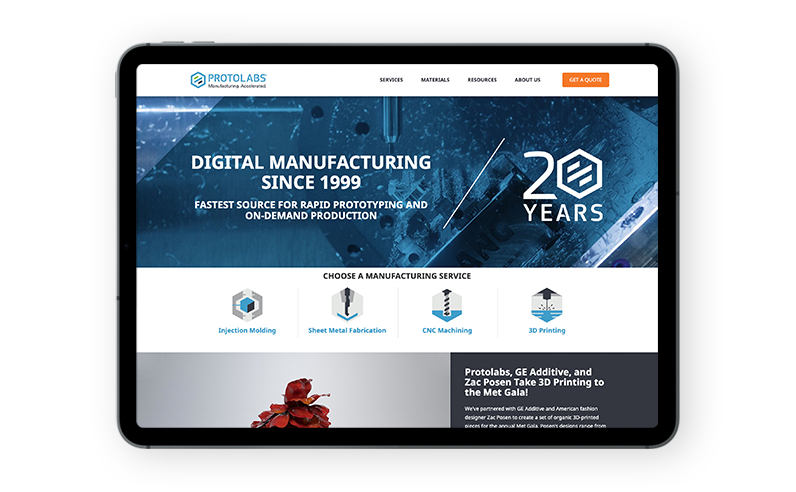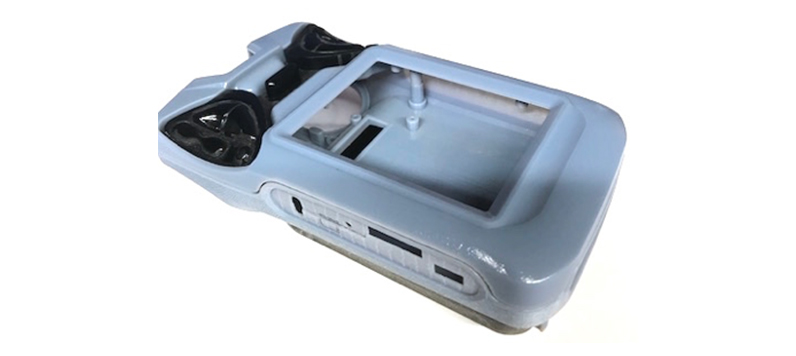Tangents
What You Need to Know About Industrial Design and Design Thinking in 2019 (Part 2)
by Joe Schappler

[wtr-time]
This post is a continuation of our previous post on Industrial Design trends.
In the last post we talked about design thinking, how it relates to industrial design, and the business value design thinking brings to both the business and the consumer. In part two, we look at a few other trends we’re seeing in industrial design, including quick turn manufacturing, the current state of qualified engineering talent, and how traditional design and development, like CNC milling, is changing with the introduction of apple-like interfaces on machines.
Quick Turn Manufacturers Dominate
Recent developments in software and automation technologies have led to the rise of a new breed of service provider: Quick Turn Manufacturers. Companies like Protolabs and a few others who are working to provide a one-stop shop are acquiring sheet metal shops, plastic injection molders, and 3D printing companies to deliver a one-stop shopping experience for both prototyping through production.
Customers are beginning to expect, or at least think about, that at some point in the future, we’re going beyond rapid prototypes and into quick-turn manufacturing leveraging rapid cnc machines and other similar technologies, and they would like to be able to do highly customized full production based on these rapid machines and new technology. They will be able to get parts quickly, produce complex parts that cannot be made with other technologies, and retain the flexibility to make real-time part improvements without the need for tooling changes.
While It’s not completely there yet, it’s moving that direction. At Helix, we’re a development company that doesn’t get too much into the manufacturing—that’s where we hand it off. We’re more involved in the rapid prototyping side of the businesses. At some point in the near future we expect it’ll be a blurry line between rapid prototyping and rapid manufacturing.
Full disclosure; Protolabs is a service that we use here at Helix. We use Protolabs and many of their competitors as well. As a design development company, the rapid prototyping evolution is exciting and extremely valuable as it continues to give us more tools in the toolbox to deliver excellent results for our clients.
3D Printing Continues to Evolve
3D printing is continuing to expand and evolve, with new machines, new materials and faster technologies. In fact, according to 3D Printing Trends Report, “The 3D printing market is set to double in size every three years with the annual growth forecasted by analysts varying between 18.2% and 27.2%.”
3D printing has become an important and integral part of our development process, with our machines running every day. It has replaced much of what we used to do with machining, getting us parts more quickly to evaluate and test. Nothing replaces analyzing a physical prototype as a better tool for development. Seeing it, handling it and doing fit checks of assemblies in almost real-time allows us to create better designs in less time. For us at Helix, 3D printing is an invaluable rapid prototype process.
There has been much discussion about 3D printing production parts. While there are suitable applications for this, I’d state that most of the time 3D printing is not practical for the end product. If a part does not need to be cosmetic and is mainly structural, we’ve seen internal component applications where this can make sense in low volumes. It does give added freedom for design changes very quickly, no tooling, and no waiting for parts.
But for products that have high cosmetic requirements, 3D printing today does not provide the surface quality, colors and finishes available from other processes. In injection molded plastics, there is an infinite array of colors, textures and finer finish qualities than available in 3D printing. There is a very large variety of available plastics with different characteristics and performances to meet just about any application. And in higher volumes, even with the capital expense of the tooling, the part price can be significantly better than 3D printing.
Don’t get us wrong—3D printing parts is still an amazing technology for some applications, even in production uses. And in prototyping, it’s an unmatched technology for development.
Recruiting Talent Is a Challenge
In almost every field, there’s a workforce/talent shortage, and that’s no different for design firms. With our business being a kind of niche, especially in engineering, finding and retaining experienced talent can be a challenge. Being a small company, we do not have formal training programs that some larger corporations do, so we mainly look for candidates with some experience and not new graduates. We do make exceptions, but the individual must be able to demonstrate capabilities that we can utilize right from the start.
How is a company to still meet the needs of the customers with a shortage of skilled labor to get the work done? After all, they sometimes come to us because of their own bandwidth issues and expect we can move rapidly on their projects. That is our business!
For small companies, it’s essential to build a team of both internal and outside resources to accommodate the ups and downs of a service business.
At Helix, we have some contractors we’ve used for 20+ years, so they are fully integrated into our processes, know the team and can assist us in delivering the quality services our customers demand. Some have skills we don’t have, and don’t need on a regular basis, so its efficient to utilize them when needed. We are always interested in expanding our network and constantly on the lookout for talented outside resources.
Talent availability goes in cycles, we saw it happen many years ago too. There was a time when there were too many engineers and we could hire them very readily. But we expect it be a continued problem for quite a while because technology is changing so rapidly today. But it will change at some point.
With high demand for certain talent, we’ve seen salaries soar, even when skill sets don’t appear to match the salary request. Because of that, in a small firm like ours, those we hire need to get up to speed very quickly and be productive to be successful. We cannot afford to take a year to get someone up to speed. This is one reason we typically look for candidates that have had some experience, even if limited, in our type of product development. They may have a better understanding of their interests and career path, and with some starting skill sets, can contribute very quickly on projects. This usually leads to a successful collaboration.
About Helix Design
Helix Design is an industrial design firm and product design company that delivers creative design and mechanical engineering solutions to companies who need external perspectives combined with practical experience. For samples of our recent work, please visit our industrial design portfolio.
Do you need industrial design guidance for your next project?
Contact us for an assessment today.



